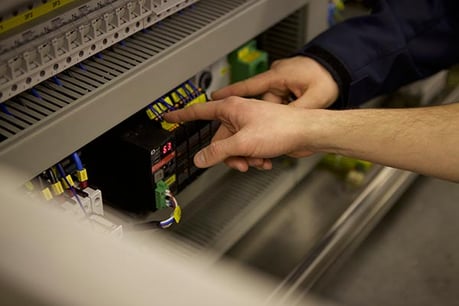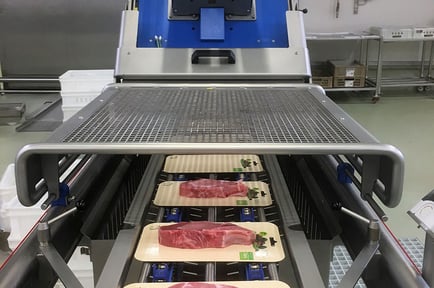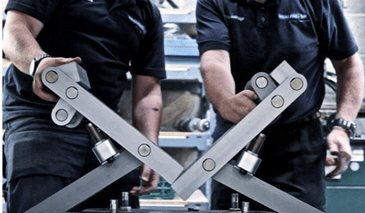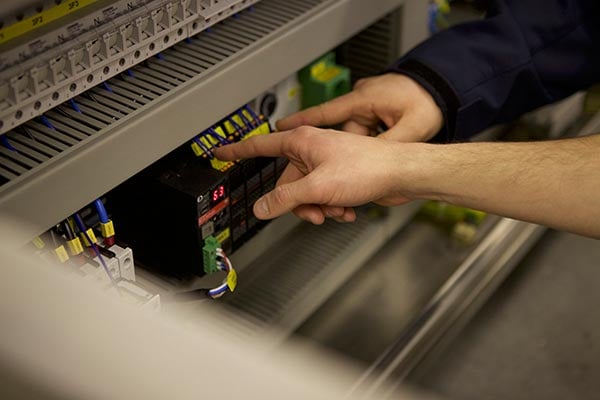The UK is currently the 9th largest manufacturing nation in the world, responsible for 45% of UK exports totalling £275bn. The sector as a whole employs 2.7 million employees and is responsible for 10% of UK output. (EEF)

Productivity remains one of the biggest challenges facing business and industry today. Time is money, but equally important is the quality of the end product. It’s therefore no surprise that manufacturers are focused on finding new and innovative ways to optimise equipment and processes, to maximise output and minimise waste.
There are numerous factors that can negatively impact on productivity and by default the bottom line. Every one of these elements can prove extremely costly to a business and its reputation. Some of the most common issues include:
-
- Machinery breakdowns
- Labour shortages
- Accidents and injury
- Workforce sickness
- High staff churn rate
- Inadequate training
So, what can you do to improve production line efficiency?
There are four key areas to consider – equipment, people, the workplace environment, and your approach. Here we’re going to take a closer look at each of these areas in turn, before suggesting steps you can take to help boost productivity.
1. Equipment
The equipment you invest in, along with how it is maintained and used, is one of the most important considerations any manufacturer has to make. Breakdowns and any associated downtime can prove extremely costly.
Work with the right supplier
Always work with a supplier you can trust, one who performs in line with recognised quality standards, has outstanding training and customer service mechanisms (available 24/7, 365 days a year) and who can grow with you as your product offering develops over time. Seek recommendations from peers and check any claims being made are genuine.
Never skimp on the maintenance
A well built and designed machine should last – potentially decades - but its longevity will ultimately come down to usage and upkeep. Preventative maintenance can help to ensure the longevity of equipment and also help increase performance levels, while having a positive impact on cycle times, so never skimp in this area. Another tip is to update your processes, to ensure you are using modern monitoring and control approaches.
– potentially decades - but its longevity will ultimately come down to usage and upkeep. Preventative maintenance can help to ensure the longevity of equipment and also help increase performance levels, while having a positive impact on cycle times, so never skimp in this area. Another tip is to update your processes, to ensure you are using modern monitoring and control approaches.
Consider automation
The manufacturing industry is facing a skills and labour shortage that’s reaching crisis point for many. While automation can be an uncomfortable topic to think about, such technology is becoming more and more of a necessity. Increasingly it is playing a significant role in production and is vital for competitiveness. No-one wants to see a human workforce replaced by robots, but one that is enhanced by automation - or where the jobs no-one else wants to do are taken over - can prove a valuable investment.
Monitor and tackle downtime
Do you know what downtime is actually costing you? Overall Equipment Effectiveness (OEE) is a key metric, which can be useful when working on reducing costs. Downtime is a core component within that calculation, but it can also be a useful figure in its own right. If you know what downtime is costing you and you can work on eliminating the causes (or at the very least have plans in place for getting back up and running as quickly as possible), then you’ll boost your efficiency.
2. People management
Staff engagement, wellbeing and development are three areas that can have broad reaching consequences for any production line.
Instill a ‘don’t just walk by’ attitude
Rather than walking on by, instilling a ‘take action’ mindset. For example, if something has fallen, pick it up. If something’s not working, report it straightaway. If something’s run out or finished, replace it or tell the person who can. Don’t live with issues, no matter how tiny they are. Encourage employees to take responsibility for keeping the environment, and everything within it, in good working order. It is often amazing how many things are just worked around, rather than improved or fixed.
Encourage and reward trouble shooting
Taking this a step further, have a system in place whereby employees can make a note of ideas and anything else they spot that doesn’t have an immediate answer. Create some kind of suggestion box. Leave slips for these ideas to be written down on and posted in. Attach a pen to the box, so there’s always one there. Even have team members carry a slip and pen in their pocket, as part of their uniform. Also consider holding regular team huddles, where employees can come together to share observations and brainstorm ideas for improvements. Even the smallest of changes can have a big impact over time and encouraging a culture of sharing and listening will also aid engagement.

Up your cross training
Avoid creating skills silos. A multi-skilled workforce will be far more valuable overall to you, while being a way to help keep team members interested. Train new employees so they are skilled in multiple areas and across different equipment - you will be increasing their skills, while reducing any potential downtime. Also consider combining certain duties, where it makes sense to do so.
Work on engagement
An engaged workforce is more likely to be a loyal one. Ask key questions regularly and make sure you listen to the answers. What do they want? What would make them personally happier in their individual role? Even just ask, how are you? Always show you recognise and appreciate hard work and those who go above and beyond. And say thank you.
3. Workplace environment
From how equipment is laid out, to break out facilities for staff, the workplace environment can have a substantial impact on efficiency.
Layout
When did you last review the layout of your machinery and other equipment? Is it still the most efficient it can be, or just the way it’s always been done? Brainstorm whether there are better, faster, more efficient ways to do things. Don’t be afraid to get the stop watch out to time things. Watch how employees are using the production line and equipment. Could a rearrangement help reduce any unnecessary manual movement? Is everything within quick and easy reach?
machinery and other equipment? Is it still the most efficient it can be, or just the way it’s always been done? Brainstorm whether there are better, faster, more efficient ways to do things. Don’t be afraid to get the stop watch out to time things. Watch how employees are using the production line and equipment. Could a rearrangement help reduce any unnecessary manual movement? Is everything within quick and easy reach?
Bottlenecks
It is crucial that you are able to spot any bottlenecks and work on reducing the reason why are they happening. Just like the neck of a bottle, the term refers to anything that is slowing output. To flow healthily, you need the whole process to be balanced. Some of the most common actions you might take against bottlenecks are to follow ‘lean’ methods of working, to revise manpower, add automation and adjust capacity where appropriate.
Happiness = productivity
Don’t just think about health and safety, think about the health, safety and wellbeing of employees. Make sure staff have access to warm clothes in winter and cold drinks in summer. Make sure people take the right breaks, preferably involving walking outside in the natural daylight, and definitely somewhere away from their work area. Is there a breakout room that’s warm, comfortable and attractive? Is there a good choice of food and drink options? And on a practical front, are they always paid properly and on time?
4. Approach and culture
Finally, give some thought to the overall culture of the organisation and what you’re trying to achieve. Look forward and consider ways to do so more effectively.
Collaborate & develop
 Share best practice and gain some valuable insights by collaborating and forming alliances with other businesses in your area. Look at a diverse range of sectors and see what you can learn from each other. Also keep up to date on industry news that may be a further source of inspiration and ideas. If you don’t have much time, sign up for an e-newsletter or similar from a relevant industry publication.
Share best practice and gain some valuable insights by collaborating and forming alliances with other businesses in your area. Look at a diverse range of sectors and see what you can learn from each other. Also keep up to date on industry news that may be a further source of inspiration and ideas. If you don’t have much time, sign up for an e-newsletter or similar from a relevant industry publication.
Check your expectations are realistic
When setting targets and KPIs, make sure your expectations of both team members and equipment are realistic. Being ambitious is a good thing but setting impossible targets doesn’t help anybody. Neither will it be motivating for your employees.
Constantly look to innovate
Lastly, the worst thing any organisation could ever say, is: ‘but that’s the way we’ve always done things’. If you hear that phrase uttered by anyone in the team, then alarm bells should be ringing! If you’re sitting still, your competitors will just pass you by. Don’t let them.
In summary, improving efficiency and the long-term performance of any production line calls for a comprehensive review of all areas of the organisation. From the workforce, to equipment, the broader working environment and organisational culture. Our advice is to strive for a culture of constant improvement and innovation, which is focused on reducing waste and achieving the optimal output.
Want to get a free consultation and find out how to get a better ROI?
Contact us now on T: +44 (0) 845 302 3056
